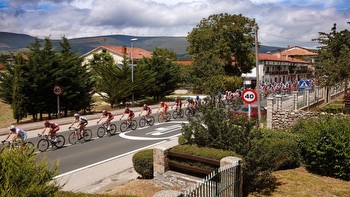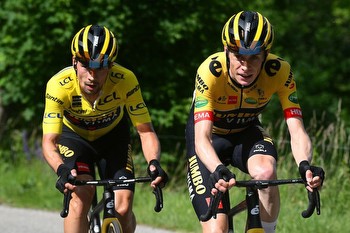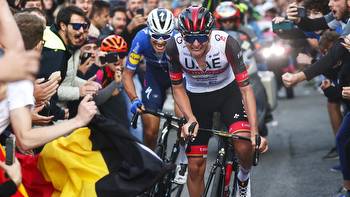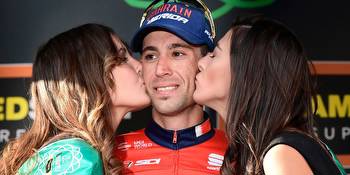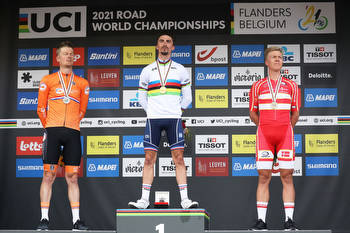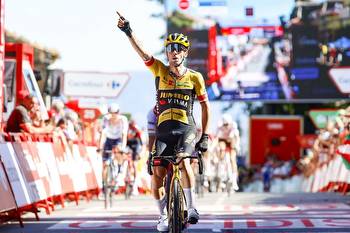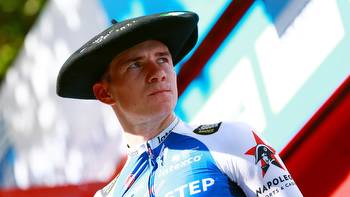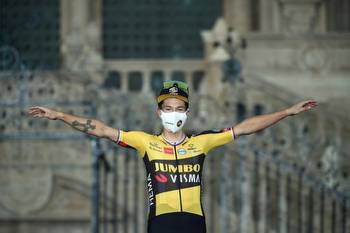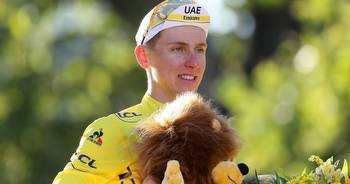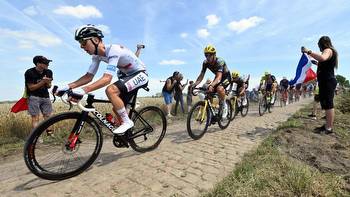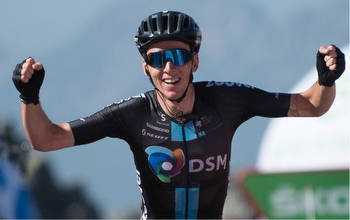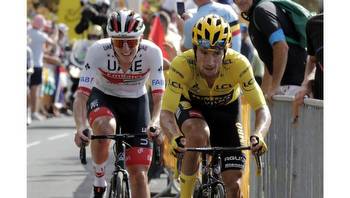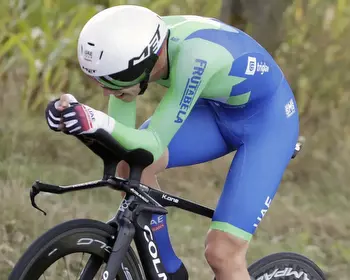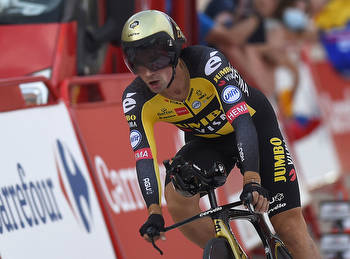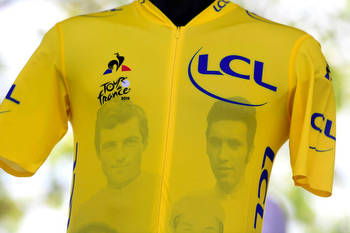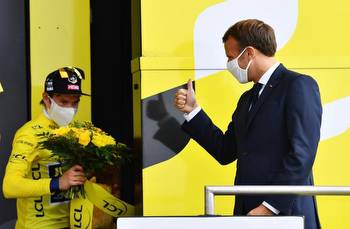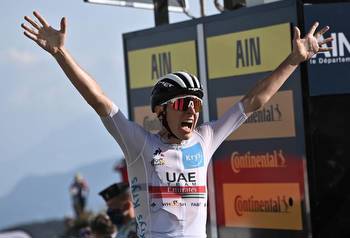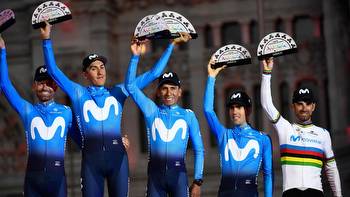The Two-Man Battle That Could Define the 2022 Tour de France

Two years ago, a 21-year-old Slovenian named Tadej Pogacar pulled off one of the most dramatic upsets in the history of the Tour de France. With just one competitive stage left and race leader Primoz Roglic ahead by almost a minute, Pogacar put in the time trial of his life to become the youngest Tour de France winner in more than 100 years.
That race reset the competitive order of professional cycling. Pogacar was established as a future star and the best rider in his discipline. And while the 32-year-old Roglic has earned an impressive series of accolades in the ensuing 21 months—two overall titles and eight stage wins at the Vuelta a España, an Olympic gold medal, a monument win at Liège-Bastogne-Liège—he still hasn’t won cycling’s most prestigious race.
He’ll have that chance soon. Friday marks the start of the 2022 Tour de France, which covers more than 2,000 miles across four countries in 21 days of racing. Pogacar will be out to tighten his stranglehold on the most famous shirt in sports; Roglic, one of the very few riders capable of stopping him, will be out to take back what was so nearly his two years ago.
A few days before that memorable 2020 time trial, I wrote a column that reflected the conventional wisdom of the time: That Pogacar was a superstar in the making, one of the most talented riders of the 21st century. But just as in the previous year’s Vuelta a España, where Pogacar had finished third and Roglic first, it seemed unlikely that he would be able to overcome the consensus best stage racer in the world.
The race up La Planche des Belles Filles changed all that. Roglic is one of the best time trialists out there, a former world championship silver medalist who’d go on to win Olympic gold in Tokyo the following summer. And he hardly choked that day; he completed the mountainous 36-kilometer course in a hair under 58 minutes, the fifth-fastest time in the race. But Pogacar showed a new level. He beat Roglic by almost two minutes, and in so doing turned the cycling world on its ear.
Since that day, Pogacar has emerged not only as cycling’s most dominant athlete, but someone who’s capable of rewriting his sport’s physical rules the way Steph Curry and Shohei Ohtani have. He defended his Tour title with ease in 2021, winning the general classification by more than five minutes and beating all but two riders by more than 10. (Vincenzo Nibali, who won by seven-plus minutes over a crash-depleted field in 2014, is the only rider since the fully-roided-up Lance Armstrong to dominate the Tour so extremely.) He took home a bronze medal at the Olympics that year; won three of the four one-week stage races he entered; and bookended his second Tour title with wins at Liege-Bastogne-Liege and Il Lombardia, two of cycling’s Monuments. In doing so, he became the first rider since Eddy Merckx to win a grand tour and two Monuments in the same season.
After all that, the comparisons to Merckx, the Babe Ruth of cycling, came thick and fast. But while the now-77-year-old isn’t above taking potshots at young superstars, even he was overawed by what Pogacar had accomplished. “I have heard many times, ‘This is the new Merckx,’ without the conditions being fulfilled,” Merckx said at a joint appearance with Pogacar last October. “But with Tadej, I think we are really there this time.”
At this point, it’s safe to say that Pogacar is the best general classification rider in the world. He has finished in the top 10 in each of his past 17 stage races, winning 11. And after completing his domination in the mountains—not just at the Tour, but in one-week stage races and one-day races like Il Lombardia—Pogacar broadened his horizons.
At Strade Bianche, an Italian one-day race over a mix of asphalt and gravel that culminates in a cobblestone climb in Siena, Pogacar won with a 50-kilometer solo attack. He sailed off the front of the peloton like he was riding to the convenience store. A month later, he tackled the Tour of Flanders, one of two cobbled Monuments, and against all odds hung with the hulking classics specialists until the end, ultimately finishing fourth. Merckx is the last rider to win the Tour de France and Tour of Flanders in his career, almost 50 years ago—nobody nowadays is capable of winning both. Or so we thought, until Pogacar showed up.
Until about halfway through Stage 20 of the 2020 Tour de France, Roglic was also viewed as a unicorn-like figure. Like most grand tour contenders, he was both a great time trialist and a great climber—but he also featured an explosiveness that most of his competitors lacked.
On mass start stages, riders are awarded the same time as the group they finish in. But to spice things up, race organizers give out bonus seconds to riders who finish in the top few places on a stage. Roglic is the best in the world at pacing up a climb and shooting past his competitors in the final few hundred meters to steal seconds here and there. At the 2020 Vuelta, Ecuadorian climber Richard Carapaz actually completed the course in less time than Roglic, but Roglic picked up enough bonuses to win the overall title by 24 seconds.
After losing the 2020 Tour, Roglic beat Pogacar at Liège-Bastogne-Liège in memorable fashion. It looked like Julian Alaphilippe had won the sprint finish, but the world champion celebrated too early and Roglic (in yellow in this video) played to the whistle and Don Beebe’d him.
But the much-anticipated Tour rematch between the two Slovenian cycling stars last year ultimately came to nothing. Roglic took a hard fall just three stages into the race and abandoned, leaving Pogacar to duke it out with Carapaz and Jonas Vingegaard, Roglic’s young Danish teammate, for the podium. The two have raced each other just once this year, at the Italian monument Milan-San Remo: Pogacar finished fifth and Roglic 17th, as a third Slovenian, Matej Mohoric, took the title by bunny-hopping curbs at highway speeds. (There’s something in the water in Slovenia, a country that’s dominating cycling despite having a smaller population than the greater Cincinnati metro area.)
The cycling calendar is decentralized enough that there are usually multiple big races occurring at the same time, and Roglic and Pogacar have chosen not to face each other much in the biggest one-week events. While Roglic was winning Paris-Nice, Pogacar was winning Tirreno-Adriatico. While Roglic was winning the Criterium du Dauphine, the mini-Tour de France that serves as a major warmup race, Pogacar went home and dominated the Tour of Slovenia.
Finally, though, these two will face off once more with the yellow jersey at stake, and the overwhelming likelihood is that one of them will wear it home. Most of the other top GC riders are sitting this one out: Carapaz targeted the Giro d’Italia earlier this year; Egan Bernal, winner of the 2019 Tour and 2021 Giro, is still recovering from career-threatening injuries he suffered on a training ride this January; and Geraint Thomas, winner of the 2018 Tour, is coming in hot off the back of a win at the Tour de Suisse, but he’s 36 years old and hasn’t podiumed a grand tour since 2019.
So the star power of this race rests with the two Slovenians. And though Roglic and his team, Jumbo-Visma, know how difficult it will be to beat Pogacar, they’ve built a squad capable of wearing the defending champion down.
It seems a little curious at first glance how much cycling is a team sport. Sure, it’s about who can get from here to there the fastest, but in order for a rider like Roglic or Pogacar to win a race, he needs teammates to set the pace, to provide a draft on flat sections so he can conserve energy, and to play the complex tactical games that define high-level road racing. If a team leader’s bike breaks down, it’s expected that a nearby teammate will give up his own bike so the leader can continue on with a minimum of delay.
One distinguishing characteristic of Pogacar’s 2020 win was how much work he had to do on his own. Had Roglic won the race, he would’ve followed a pattern of champions with strong team support. He seemingly always had someone with him to help pace the tougher parts of the race, while Pogacar hung on for dear life.
Pogacar’s team, UAE Team Emirates, has rectified that weakness in the past few years by bringing in a strong set of domestiques: Rafal Majka, two-time winner of the Tour’s mountains classification, 2018 Paris-Nice winner Marc Soler, and 24-year-old American hotshot Brandon McNulty.
But Roglic still has the stronger team. Two of Roglic’s Jumbo-Visma teammates—Vingegaard and Steven Kruijswijk—are Tour de France podium finishers in their own right. Wout Van Aert, winner of six Tour de France stages and three cyclocross world championships, might be the best all-around cyclist in the world. And Roglic’s most valuable teammate might be 27-year-old Sepp Kuss, the only active American to win a Tour de France stage. Kuss is the best pure climber the U.S. has produced in the past 10 years. But while his own accolades are relatively limited—one stage win each at the Tour and the Vuelta—that’s because he’s spent the past four seasons as Roglic’s sherpa, pacing him through the toughest climbs in the biggest races.
At this level of cycling, controlling the pace of the race is of paramount importance. It has to be fast enough to shake off all but the strongest riders, but slow enough and even enough that the team’s leader still has the energy to attack after four or five hours of work.
A successful attack usually takes meticulous planning and sometimes an entire afternoon’s worth of setup. But Jumbo-Visma’s roster is so stacked, there have been multiple occasions in big races this year when they’ve been able to bum-rush the peloton en masse, as Roglic, Van Aert, and Christophe Laporte did in Stage 1 of Paris-Nice, and Roglic and Vingegaard did in Stage 8 of the Dauphiné.
Vingegaard, specifically, could be the rider who does the most to influence this race. When Roglic hit the ground at last year’s Tour, Vingegaard was unproven, but he came closer than anyone to matching Pogacar in the mountains; he even dropped Pogacar on the iconic Mont Ventoux climb. Vingegaard finished second to Pogacar at Tirreno-Adriatico, and during the eight stages of this year’s Dauphiné, he was climbing just as well as Roglic. Had the two chosen to race each other up the race’s decisive climbs, the 25-year-old Dane may well have beaten his team leader.
That gives Jumbo a huge advantage. They not only have a team fit to control the race over any terrain, they have two legitimate general classification threats for Pogacar to mark. If he attacks, Jumbo’s two leaders can work together to reel him back in. If Vingegaard attacks, Pogacar will have to expend more energy to chase him down, leaving him vulnerable to a counterattack from Roglic. And if that tactic doesn’t work the first time, Roglic and Vingegaard could repeat it until it does.
The last time Pogacar lost a stage race was last year’s Tour of the Basque Country, which McNulty led heading into the final stage. Roglic and Vingegaard were close behind, with Pogacar in fifth place, riding to protect McNulty’s lead. McNulty cracked after a Roglic attack more than 50 kilometers from the finish, and by the time Pogacar abandoned his teammate, Roglic had too big a head start for Pogacar to reel him back in.
That’s a reminder of how fortunate Jumbo-Visma is to have a co-leader as strong as Vingegaard, but it also reflects a potential speed bump for Roglic. There comes a point in a stage race where even the strongest rider might have to sacrifice his own ambitions to work for a teammate in a better strategic position. If it can happen to Pogacar, it can happen to anyone.
And it doesn’t take a ton of imagination to foresee a scenario in which Vingegaard ends up ahead of Roglic in the standings. Maybe a series of rolling attacks by Jumbo-Visma ends with Vingegaard, not Roglic, pulling off the move that Pogacar is unable or unwilling to follow. Maybe Roglic gets a flat tire at a bad time. Or maybe Vingegaard, racing on home soil in Copenhagen, puts time into his competitors in the Stage 1 individual time trial. As good as the two Slovenians are against the clock, Vingegaard has finished in the top 10 in two of his three time trials this year; across two time trial stages in last year’s Tour he lost an aggregate of two seconds to Pogacar.
A straight fight between Roglic and Pogacar favors Pogacar. But adding Vingegaard into the equation shifts the competitive balance significantly. Can Roglic beat Pogacar? Maybe. Can Roglic, in concert with Vingegaard, ensure that at least one Jumbo-Visma rider wins the Tour de France? Absolutely. If Pogacar is the perfect stage racer, Jumbo-Visma has built the perfect stage racing team. It might be the only thing that can bring the reigning champion down.

